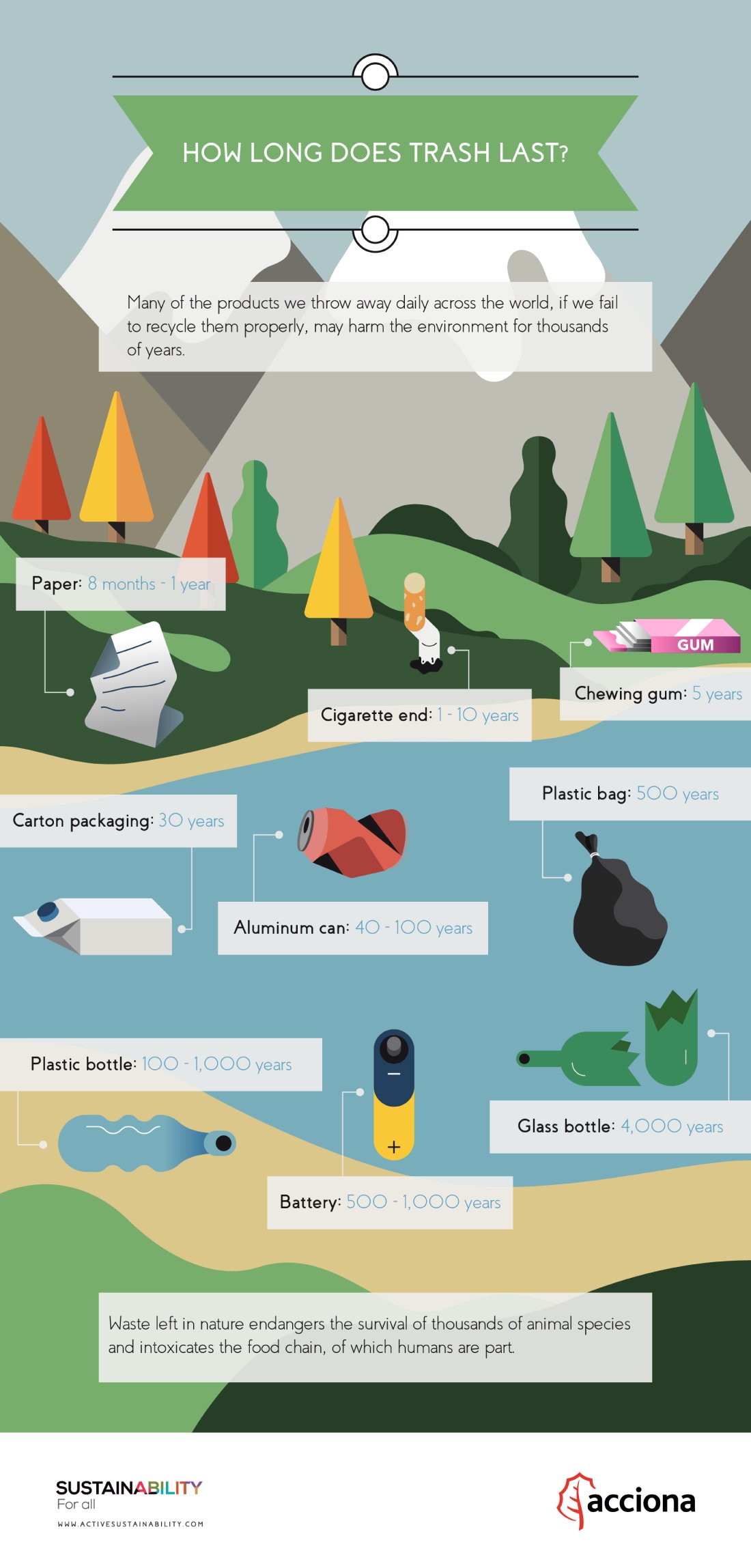According to a World Bank report, it is estimated that, in developed countries, one person generates an average 1 kg of waste per day: cans, plastic, glass, electro-domestic equipment, etc. An environmental problem that becomes even more complicated if, as well as producing waste, we discard it irresponsibly and anywhere. We are not, unfortunately, talking about sporadic behavior here: this conduct that clutters fields, rivers and oceans, has a name: littering (abandonment of waste).
How long does waste last?
A cigarette butt discarded on the beach, because the waste bin is too far from your towel, or a plastic bottle forgotten in the countryside which, for the poor memory of its owner is destined to stay there for years, are just two examples of the waste that fouls nature, one of the biggest problems faced in biodiversity conservation.
In fact, 80% of the trash that causes the pollution of the sea comes from the waste we throw away, not just on the coast but also inland, from where it travels down the rivers and washes up into the sea.
Without human intervention, nature would have no waste. Natural elements fulfil a function and are reused in one way or another for their usefulness in different stages, cyclically. A chewing gum or tin, however, cannot take part in this cycle after being abandoned in the countryside, and it remains there for years, in some cases centuries.
What kind of time periods are we talking about? The following infographic explains how long it takes various forms of waste to descompose once they have been discarded to nature, from a simple scrap of paper to an aluminum can:

All these discarded items, with improperlywaste management, represent one of the most important pollution problems facing the planet. In the worst of cases, they filter into the food chain of birds and fish, of which humans form part.
The following alarming figures speak for themselves: 4.8 million tons of plastic, discarded on land, ends up in the sea each year; as a result, at least 267 species are trapped in plastic waste or swallow it, says the United Nations, and it is estimated that, in 2050, 99% of sea birds will have eaten some type of toxic waste in their lifetime. Because of this, it is very important the plastic recycling. Let’s see how they are affected by the different kinds of litter:
Cigarette ends: 10 years
Irrespective of size, every butt left on the beach or in the countryside is harmful waste polluting the environment in many ways and lasts 10 years. According to the NGO SEO/BirdLife, a single butt can contaminate between 8 and 10 liters of water. But that’s not all: it could also end up in the stomach of an animal that cannot digest it.
Cans: up to 100 years
Soft drink cans and canned food tins are made from aluminum, a material that can take between 10 and 100 years to decay, depending on the thickness, and which generates iron oxide. For this reason, it is important the waste recycling. The survival of species such as sea turtles, and many birds, is endangered when they are caught in the rings of these tins.
Plastics: up to 1,000 years
In this category, we encounter many formats and variants invading the planet’s landscapes and oceans, resulting in what we now know as garbage patches or trash islands. Water bottles, for example, lead the way as far as longevity is concerned; numerous studies suggest they can take up to 1,000 years to degrade. During all this time, the sun is able to crack them and break them up into fragments, converting each item into a host of microplastic debris that birds and fish often end up eating. Chewing gum, for its part, is made up of 80% plastic. As small as a piece might seem, it is estimated it would need five years to disappear and now consists of one of the waste products species most often confuse as food.
Glass: up to 4,000 years
A frightening 4,000 years is how long it takes a glass bottle to decompose in the environment. Every time we leave a recipient of this kind in the countryside, we are putting the environment and its ecosystem at risk. As occurs with many of the elements above, animals can cut themselves on glass or ingest it without being able to digest it. It is also a very dangerous fire risk factor. Paradoxically, while it is one of the most polluting and longest substances in degrading naturally, glass is completely recyclable and does not generate waste in the process. It is transformed into a product with the same characteristics without losing its properties, thus the importance of sending each product we use for recycling.
A solution inspired by nature

But what can we do to reduce the problem? We have found an important solution by copying nature: nature throws nothing away but is able to use and reuse its elements. This cyclical model is the inspiration for the circular economy, one of the most effective weapons for fighting waste pollution. The philosophy of the circular economy is to reduce production and instead opt to reuse the elements that, for their properties, cannot return to the environment, converting such waste into a resource.
Another essential solution resides in each citizen taking responsibility for recycling, since waste such as aluminum, glass, paper and carton can have the opportunity of a new life through transformation. Also, however, certain public and private initiatives, by companies like Terracycle, are collecting waste difficult to recycle, such as cigarette ends and coffee capsules, and giving them a new use.
Waste abandoned to nature puts at risk the equilibrium of the ecosystem and the lives of over 15,000 animal species. Do you think we can do something to change this?
Source: Naciones Unidas, Word Bank y SEO